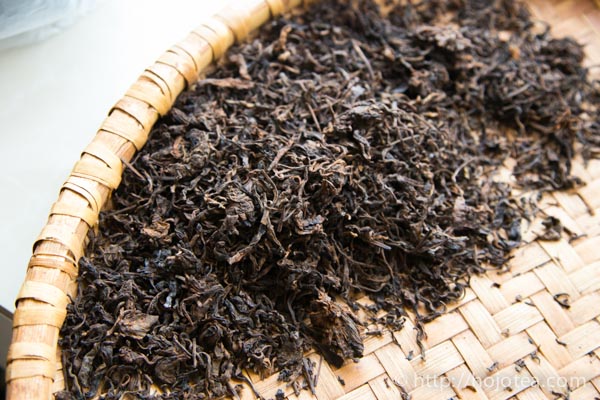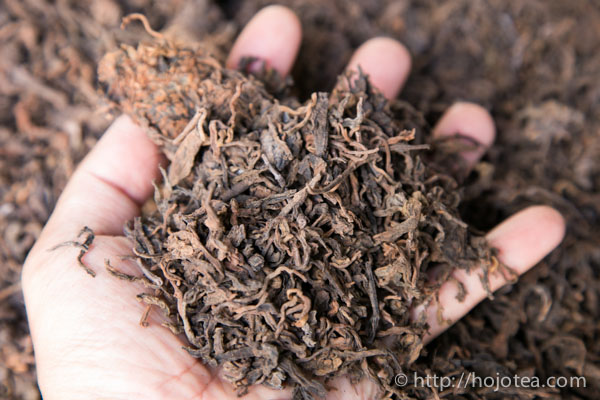- HOME >
- Tea Processing
The Secret of Grading on Ripe Pu-erh Tea

The ripe Pu-erh tea is often classified into various grades. The highest grade of the ripe Pu-erh tea is called the Imperial Grade (宮廷普洱), followed by the Special Grade, the Gift Tea Grade, 1st Grade, 3rd Grade, 5th Grade, 7th Grade, 8th Grade and till 10th Grade. However, the grading of ripe Pu-erh tea does not accurately reflect the quality of the tea. Thus, I would like to share more about the details as follow.
Ripe Pu-erh tea is processed from the leaves that contain one bud and two to three leaves
The raw material for the ripe Pu-erh tea is the raw Pu-erh tea which composes of 1 bud and 2-3 leaves. Therefore, the production of ripe Pu-erh tea involves the fermentation of raw Pu-erh tea with some micro-organisms. Basically, both the raw and ripe Pu-erh tea leaves are of roughly the same appearance, except for the ripe Pu-erh, the tea leaves are slightly more fragmented into smaller sizes due to the mixing and other handling during the production. After the fermentation, the leaves are then called mao-cha in Chinese.

The grading of ripe Pu-erh tea is carried out with sieving
The mao-cha of ripe Pu-erh tea is occasionally compressed as it is. However, in most cases, the mao-cha is classified into various grades where the grading is carried out mainly using a sifter or sometimes, other type of sorting equipment such as a gravity separator. The mao-cha of ripe Pu-erh tea is further classified into groups such as bud, leaf, stem and so on where each fraction of leaves collected during sorting process are classified into different grades. The higher grades of ripe pu-erh tea contain more buds, while the lower grades have more leaves in bigger sizes.

The tea on the left is the mao-cha and the one on the right is the special grade collected after sieving.
The grading of the ripe Pu-erh tea does not mean identifying the tea’s quality
As mentioned, out of many grades, the finest grade is called the Imperial Grade that consists of mostly the tea buds where the price is usually higher. The colour of the tea buds are of golden colour and it looks gorgeous. But, on the contrary, the grades of ripe pu-erh tea that consist of many stems are usually considered as a lower quality tea. However, we should not forget that all grades of tea originate from the same material and the grading of ripe Pu-erh tea has nothing to do with the quality but the cup characteristics. In addition, different parts of the leaf produce different intensity of body, after taste and flavour. Somehow, the satisfaction of enjoying a cup of tea does not depend on its proportion to the grading. For example, the imperial Pu-erh tea is the most expensive tea but it does not mean it will produce the best drinking feeling. The imperial Pu-erh produces a very delicate and soft mouth feeling, yet it emits a lighter body and after taste when compared to the rest of the grades.
Regardless of which country, there are a number of customers who tend to judge the tea quality based on its appearance since it is an easier way; in other words, where there are ‘more golden tips, the better the quality’, is what they usually presume. As a result, the present grading method has developed due to these trends. In any case, the quality of tea should be judged from the after taste, body and flavour, rather than just the appearance.
Imperial Grade
The imperial grade is called Gong Ting in Chinese. If you are interested in this grade of tea, please try our “Gong Ting Jing Hao”. Jing Hao means “Golden Bud” in Chinese.
Related Articles
How to get the latest update on HOJO?
1. Follow Twitter, 2. Click "Like" on Facebook, and 3. Subscribe in newsletter. You can have the latest tea news from HOJO.
 Subscribe the Newsletter to enjoy the privileges
Subscribe the Newsletter to enjoy the privileges- You may receive a free sample upon purchase, or you may have the priority to purchase special products. So please remember to subscribe our newsletter as well as the social network.
- Myanmar White Tea Bud 2013 from Guo Gan, Myanmar
- We have released a raw Pu-erh tea, 緬甸白芽茶 2013 (Myanmar White Tea Bud 2013), produced by ethnic minorities in t …
- Yong De Wild White Tea 2025 Loose Leaf Limited Release
- We have released Yong De Wild White Tea Loose 2025. For the 2025 harvest, only the loose-leaf type was …
NEW ARTICLES
 Myanmar White Tea Bud 2013 from Guo Gan, Myanmar
Myanmar White Tea Bud 2013 from Guo Gan, Myanmar- We have released a raw Pu-erh tea, 緬甸白芽茶 2013 (Myanmar White Tea Bud 2013), produced by ethnic minorities in t …
 Yong De Wild White Tea 2025 Loose Leaf Limited Release
Yong De Wild White Tea 2025 Loose Leaf Limited Release- We have released Yong De Wild White Tea Loose 2025. For the 2025 harvest, only the loose-leaf type was …
 Experience the True Freshness of Raw Pu-erh : Tang Jia 2025 Loose Leaf Release
Experience the True Freshness of Raw Pu-erh : Tang Jia 2025 Loose Leaf Release- We have released Tang Jia Raw Pu-erh Tea 唐家古樹生茶 2025 Loose Leaf. Among HOJO’s raw pu-erh teas, Tang Jia Raw Pu …
 Yunnan Chun Jian Green Tea from High Mountain Gardens
Yunnan Chun Jian Green Tea from High Mountain Gardens- Yunnan Chun Jian Green Tea is now available. This tea is made from naturally grown leaves harvested from high …
 Limited Loose Leaf Release of 2025 Da Xue Shan Wild Raw Pu-erh Tea
Limited Loose Leaf Release of 2025 Da Xue Shan Wild Raw Pu-erh Tea- We have released the 2025 loose-leaf version of Da Xue Shan Wild Raw Pu-erh Tea. This tea comes from wild tea …
 Discover a New Way to Enjoy Tea: Cooking Rice with Tea
Discover a New Way to Enjoy Tea: Cooking Rice with Tea- Cooking rice with tea is a simple idea, but it brings surprisingly satisfying results. The tea’s flavour seeps …
 2025 Da Xue Shan Wild White Tea Now Available from Yunnan
2025 Da Xue Shan Wild White Tea Now Available from Yunnan- The 2025 harvest of Da Xue Shan Wild White Tea is now available. Crafted from truly wild Camellia taliensis tr …
 Fresh 2025 Yunnan White Tea – Select Your Favourite Lot Before Blending
Fresh 2025 Yunnan White Tea – Select Your Favourite Lot Before Blending- Freshly crafted in Yunnan and just arrived in KL, our new 2025 white tea is now available at our Gardens Mall …
 2024 Dong Shan Raw Pu-erh Tea – Crafted with the Producer for Desired Quality
2024 Dong Shan Raw Pu-erh Tea – Crafted with the Producer for Desired Quality- We have released the 2024 cake of Dong Shan Raw Pu-erh Tea. Earlier, we offered the loose-leaf version from th …
 Development of Firewood Roasted Hojicha Using Naturally Grown Tea from Yunnan
Development of Firewood Roasted Hojicha Using Naturally Grown Tea from Yunnan- We are currently staying in Yunnan Province for tea production. As the season nears its end, tea trees with pa …
Category
- New Arrival at HOJO Online Shop
- Featured Articles
- Newsletter
- Types of Tea
- Origin of Tea
- Teapot and Tea Equipment
- Tea Column
- How to enjoy tea
- Tea Processing
- How to choose quality tea
- Tea constituents and functional effect
- Safety of Tea
- Foods
- Tea Business Operation
- Hobby and Outdoor Activity
- Ranking of Tea
- Video
- FAQ
- Media Release
Profile

- AKIRA HOJO
- I invite you to experience my tea selections.I was born in Nagano, Japan. In university, I studied agricultural chemistry, and I have the master degree in food science. I worked in Japanese food industry for 10 years. I involved in R&D, QC and QA. As a factory manager, I implemented ISO9000 series and managed the factory.
- The Art of Tea Magazine
- We posted the article on “The Art of Tea Magazine No.9, the magazine is published in Taiwan. We featured …
- New Straits Times
- The Malaysian National Newspaper, New Straits Times featured HOJO Tea on 17-Oct-2007.
Shop Info

Address:Lot No. T-215, 3rd Floor, The Gardens Mall, Mid Valley City, Lingkaran Syed Putra, 59200 Kuala Lumpur
Tel: +603-2287-4537
Business Hour: 10am to 10pm
















